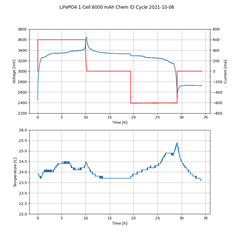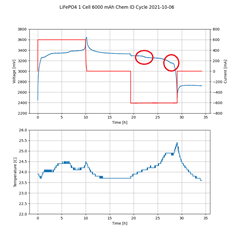Other Parts Discussed in Thread: BQ34Z100EVM, , BQ34Z100
I am using a bq34z100EVM to perform a learning cycle for a 4S32P 200Ah LiFePO4 battery pack.
- The voltage divider resistor R1 is replaced with 270 k, the R28 with a 18 k resistor and a jumper is placed to pins 1 and 2 on the header J2 to set the voltage divider to 270 k/18k.
- The current shunt resistor R30 is replaced with two 5 mR 4 W resistors in parallel resulting in a 2.5 mR shunt.
- Current and capacity values have been scaled down in the bq34z100-G1 configuration by a factor of 7.
According to the Technical Reference Manual sluubw5 and the Achieving the Successful Learning Cycle Application Report slua903, the VOK bit should clear in 2 h after charging the battery to full, but it has been 10 h after completing the charging cycle and the VOK bit is still HIGH, OCVTAKEN is LOW.
Should I wait for longer and for how long or should I move on to discharging the battery?
Has the learning cycle failed and if it has then why?
Also, the Learned Status changes from 0x04 to 0x05 immediately after completing the charge not after two hour rest period. Is this behavior expected?
I have attached the learning cycle log up until this point and the Data Memory exports. Chemistry ID is set to 0418. Let me know, if some more information is necessary.
bq34z100-G1_200Ah_LiFePO4_learning_cycle_2021_09_29_02_10-2021_09_30_09_15.zip
Feedback is appreciated!




